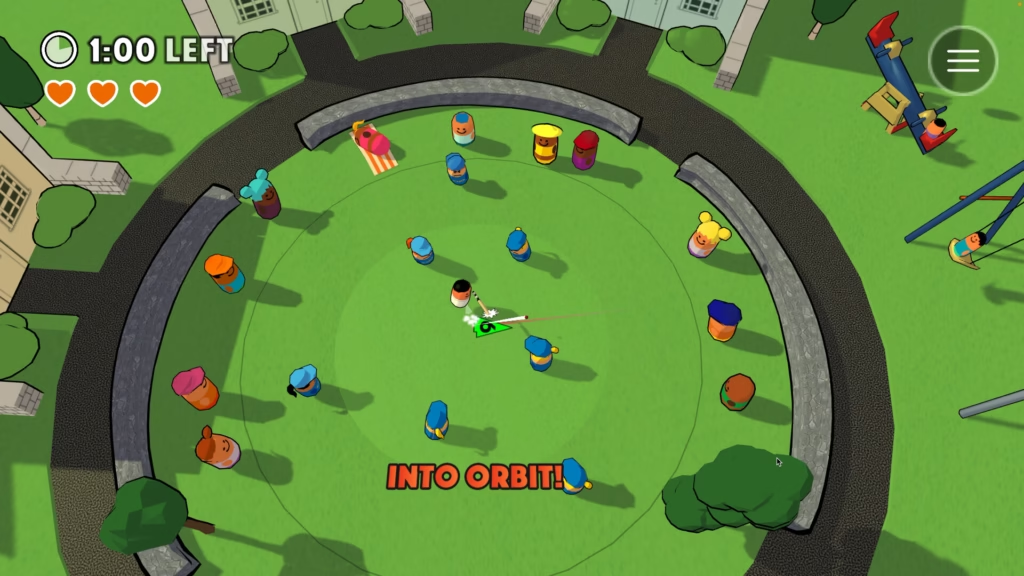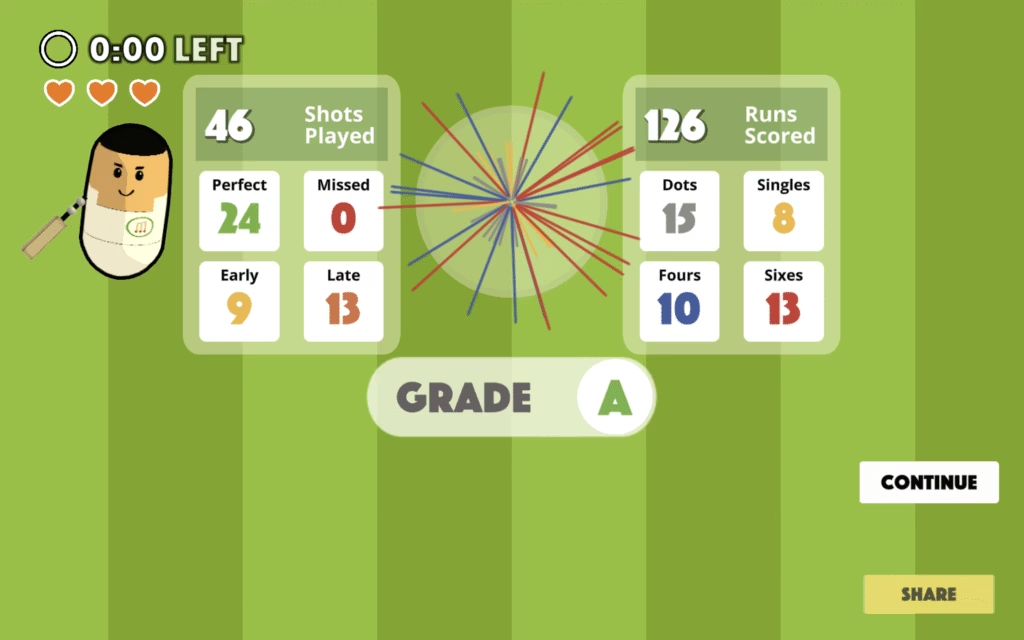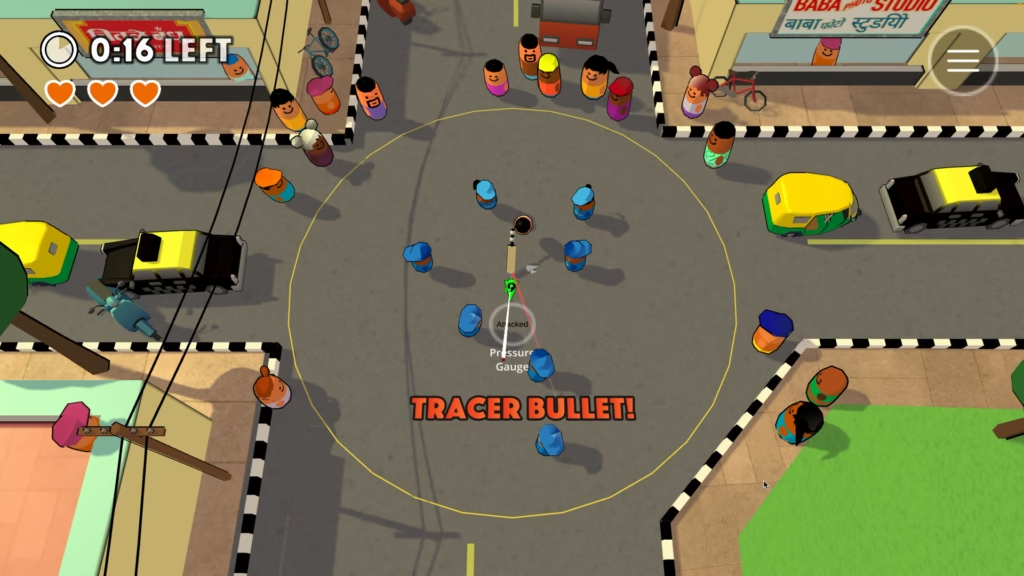The genre of rhythm games really only came into prominence in 1996 with the launch of PaRappa the Rapper — an easy-to-grasp title chock-full of infectious beats and certified earworms. But, gamers had been tapping buttons to a rhythm (or, very loosely, on rhythmic cues at the very least) since as early as 1983’s Dragon’s Lair, widely accepted to be the first game to introduce quick time events (QTE) as gameplay mechanics.
And over the years, QTE and rhythm have been ever-present (whether as a full-fledged game or as mechanics in games) on the gaming horizon. In some cases, they’re reinventing gameplay as in Hi-Fi Rush and in others, like the Like a Dragon/Yakuza series, they’re enhancing battle sequences and lending themselves to surprisingly deep minigames. An area from which you wouldn’t necessarily think a rhythm game would emerge though is cricket. After all, even at its most intense (nay, especially at its most intense), the game moves to the languid beat of its own drum.
Enter Kunal Joshi. Ann Arbor, Michigan-based data scientist by day, game developer/music composer by night, he is the solo dev putting together Bat to the Beat. “The game represents a confluence of my interests: Obviously I like cricket, I enjoy music and dabble in composition, plus I also really enjoy rhythm games,” says Joshi, “Doing something — whether that’s hitting four buttons or just one — in sync with music is a very powerful sensation.”
Elaborating on his love for rhythm games, Joshi names Guitar Hero, Rock Band, Rhythm Heaven Fever and Crypt of the NecroDancer as some of his favourites. “As a game designer, I wanted to do something a little different. You see with a lot of rhythm games, there’s this idea of memorisation and repetition of patterns until you get it perfect,” he explains, “Except for games like Hi-Fi Rush and some others, there isn’t really the concept of dynamic decision-making in this genre.”
The origin story
Timing became the common thread to tie music and cricket together, and this would also become Joshi’s starting point as he began cooking up his rhythm game. “My initial prototype actually was a one-button game where you’re hitting shots in time with the beat — which was functional, but it felt like a standard rhythm game,” he recalls, “Then it evolved into this two-button thing where you’re making dynamic decisions (hit or defend) just based on where the fielders are located.”
Pointing out that the ‘one-button thing’ was no more than a quick prototype he put together over a few days or a weekend, the Bat to the Beat developer says that he wanted the game to have a bit more depth. “How do I get from just one button where you’re hitting to the beat to something a bit more? And that’s where the pressure angle came in,” he adds. And it was the ‘pressure’ aspect that brought in the two-button concept.
Joshi explains, “Along with a hit button, there was a defend button added. But then I started wondering what’s to stop someone from just defending endlessly? And that’s when I thought of how most modern-day batters start getting antsy if they play out one or two maiden overs.” With every defensive shot, the pressure gauge begins to fill up until it is full and the batsman is declared out. “Another change I did make was that I initially had the fielders in the same position every time. But then I decided that if I’m making gameplay dynamic, field positions should also be dynamic — and so they’re randomised.”

It’s worth noting at this point that Joshi was still very much working in a silo. “A lot of the time when you’re a solo developer, you’re working alone and you scale the difficulty level up or down based on your own impressions,” he says, “After a while I took the most current build at the time to a local expo and of the 50 people who tried it, only one could finish the first level. That was when I decided that I should probably scale the difficulty back a bit.”
He would then go on to build a mini tutorial, followed by a level, and then another tutorial, followed by another level and so on until the basics of gameplay were laid bare before the player. (You can check out these tutorials on the demo available on the game’s Steam page.) “The first two levels of this tutorial should be easy enough for most gamers to finish in a couple of tries at the most,” says Joshi, “I wanted people to get a bit taste of what they can expect because there’s quite a high ceiling to this game in terms of skill levels and stuff.”
One of the most intriguing things about Bat to the Beat, certainly one that first caught my eye, was that it more closely resembles the schoolyard game of French Cricket rather than the real thing. For the uninitiated, this sees a batter standing in a circle and protecting their legs (that play the role of wickets) from the ball. And upon striking the ball, runs are made by spinning the bat around one’s body. Each spin equals a run. Was this what Joshi was going for when he devised the game, I wondered.
“This was the first thing that came to mind and it just seemed to work well with the whole format,” he admits, “You can place the fielders all around and the game marker goes around the batter. I did think about ways of making it a bit more like real cricket, but I couldn’t come up with a way that felt as elegant as the current setup.”

On inspiration
Describing his own cricketing journey as largely a school-college affair and himself as more of a batter than a bowler, Joshi reveals that the biggest inspiration for Bat to the Beat came neither from a cricket game, nor from a traditional rhythm game. “I would say Terry Cavanagh’s Super Hexagon was the biggest inspiration for me,” he says, “It’s also a two-button game, but you play this tiny triangle that is navigating its way through these obstacles that are falling in a radial fashion. It’s absurdly difficult, but I really enjoyed it. The game also demonstrates how you can have a really simple control scheme, but it requires a pretty high skill level to complete it.”
Other games that inspired him in this journey include Rhythm Heaven Fever, a Nintendo title that includes various minigames — each of which is based on some rhythmic aspect. “It doesn’t necessarily have that choice aspect or dynamic decision-making that you’ll find in Hi-Fi Rush or even Bat to the Beat, but it incorporates all sorts of different rhythms,” he adds, “And this includes input mechanics, like you can either just tap a button, or do a long-press or a double tap and so on. That was a good reference point for how to bring in these various elements.”
As he explains, this variety of inputs adds a great deal of depth and richness to levels. If, for instance, the game stuck to single-button presses, it would most likely have restricted the sorts of rhythms that could’ve been implemented and the challenges that could be issued to players. “With all the single taps, double taps, hold and release bits, it allows gameplay to be a lot more expressive in a sense,” Joshi continues, “Just as in music where you can fave single notes, chords, sustained chords, arpeggios and so on.”
The third key inspiration for this cricket-rhythm game was Crypt of the Necrodancer. “It’s this sort of roguelike thing where you’re doing actions in sync with the beat,” he elaborates, “It also has that whole pixel art chiptune aesthetic going for it. And one of the things it does extremely well is to bring in a sense of player choice, but in sync with the rhythm.”

The musicality of it all
At the time of writing, the playable demo sports four different levels: England, the West Indies, India and Australia. And while they all possess their own little charming visual attributes, it’s the music that’s the star — because ultimately that’s what you have to keep the beat to. “Some of the music is dictated by how each level is being introduced and the where in the learning journey players find themselves. So I was quite clear that the first level had to be a conventional 1-2-3-4 beat,” he says, “So when it came to the England level, there’ve obviously been so many famous bands from there, but I like the drum and bass genre and I wanted something where the bass is the star.”
Moving to Jamaica, the first things that probably jump out are reggae, reggaeton and ska. “I mean, reggae is probably the first thing you’d think when it comes to Jamaica. And I thought that’d be a nice level for the next one because in reggae, there’s a heavy use of the ‘offbeat’,” Joshi points out, “So I felt that would bring in a way in which I don’t have to introduce a new input mechanism, but a new type of rhythm for players to wrap their minds around.”
Next stop: India. “I began deconstructing a few Bollywood songs for this level, and unlike a lot of western music, there aren’t many guitar or drum tabs out there for this sort of music,” he says, “So I began using this tool called Neural Mix Pro that allows for Stem separation — basically you can take any song and break it down into its various components like vocals, harmony, bass, and percussion.” It was during that bit of sonic dissection that Joshi noticed that a lot of Bollywood songs, particularly modern ones, have a common beat. And that was his excuse to bring in the double-tap as a form of input.
“After that, I just tried a few other things, like some simple chord progressions and a simple melody line that that flowed after. But it was only once I’d narrowed down on the rhythm part that I could build everything around it,” says Joshi. And finally, there was Australia. For the Bat to the Beat developer/composer, the inspiration for the musical theme of this particular location was a no-brainer. “It had to be AC/DC, with sustained guitar notes and chords, high energy and all that. That part was quite easy.”
With the ideas firmly in place, it was a case of actually composing the music, and for the most part, he’s been playing it himself. “I’ve been handling the guitar and drum parts, but a friend — who is a really accomplished bass player — has been handling base duties for the game,” he says, “I feel like the bass has actually been kind of the centrepiece of [the music]. For instance, in the Jamaica level, the bass is clearly the star. Bass also plays a prominent role in the England level.” Most of the guitar and bass stuff was recorded live, Joshi adds, while a majority of the drums, synths and other instruments were put together using a MIDI keyboard and some software instruments.

The innings ahead
With a late 2025 release date firmly in his sights, Joshi’s been busily working on fleshing out the remaining levels. New Zealand, Sri Lanka and South Africa are the ones currently under the scanner. “It’s been fun exploring the musical genres of those countries, as well as trying to see what kind of music from there would fit the game,” he says, and when I ask about specifics, he replies, “Well, for New Zealand, I’ve settled on this style that they call Dunedin Rock, which has fuzzy guitars and an indie rock sound.”
Before we wrap up, I enquire about how challenging he finds the process of composing music across a variety of genres with a view to getting them to fit a certain beat. “Constraints help with creativity. So, if you had a blank slate, you could do a million different things, and then eventually, you’ll just be stuck,” says Joshi philosophically, “On the other hand, having one constraint to navigate actually makes the whole process easier. For example, in that Bollywood example I gave earlier, once I’d narrowed down on that groove and established the constraint, we were able to compose music that would fit that groove. The other constraint comes from the game design aspect where I don’t want to make things too complex, at least this early in the game.”
And finally, why should people look forward to Bat to the Beat? “I think the biggest draw is that it’s easy to pick up and play, but there’s a lot of richness and depth to the game,” says Joshi, “And I think anyone who’s into cricket or into music or is looking for something a little different, will have a lot of fun with Bat to the Beat.”


